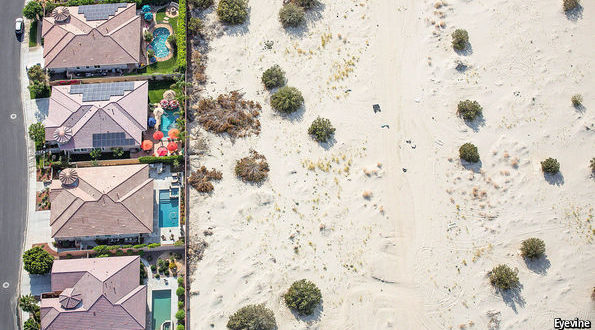Dry California – All the leaves are brown
Published on January 29th, 2016
January 30, 2016
The Economist
Even torrential rain brought by El Niño may not end California’s drought,
STILLNESS pervades the South Los Angeles Wetland Park. A turtle floats by, undisturbed by lunch hour at the high school opposite. Tall bulrushes bend around the pool at the centre of the nine-acre (3.6 hectare) site. The water comes from the city’s storm drains, cleaned of oil and rubbish. Completed in 2012 for $26m, the park captures urban run-off after wet weather—vital in a state suffering from severe drought. Water from rain in recent weeks, brought largely by El Niño, the world’s largest climatic phenomenon, now flows through the park’s fountains. More will come.
El Niño sees warm water, collected over several years in the western tropical Pacific, slosh back eastwards after the weakening, or reversal, of winds that blew it there. This affects atmospheric cycles, and therefore weather patterns, around the world. The current Niño is one of the strongest on record; its rivals in 1982-83 and 1997-98 ushered in two of California’s wettest years after storms between January and March.
In the first week of this year more than 100mm of rain fell near Lake Tahoe; snow turned the Golden State’s peaks white. At Mount Waterman ski slopes have opened for the first time since 2011. The Los Angeles fire department has prepared more than 200,000 sandbags; churches and shelters have flung open their doors to the 18,000 or so living on the city’s streets. Across the state, the number of people with flood insurance has jumped by 12% in recent months, according to the Federal Emergency Management Agency.
Such foresight makes sense. El Niño caused more than $500m-worth of damage 18 years ago. Rainfall on dry, cracked ground is likely to run across it, not soak in, causing flooding and mudslides. And the state is truly parched: California has missed more than a year’s worth of precipitation. Three months ago, about 46% of the state was suffering “exceptional” dryness according to US drought monitor, a research tool; now just less than 43% of it is.
Yet even if California endures ark-worthy deluges, the drought will probably persist anyway, says Noah Diffenbaugh, a professor of earth-system science at Stanford University. Studies published in recent years agree that for the past three winters a region of high atmospheric pressure off the coast has diverted seasonal storms to the north. Underground aquifers, raided mercilessly to compensate, will not recover quickly. They may have provided as much as 65% of the water used in the state in 2014—up from 40% during average years—according to the California Water Foundation, an environmental group.
Snow, as well as rain, is needed to quench the state’s thirst; it supplies about a third of the water needed by cities and farms. It falls in the Sierra Nevada in the winter; meltwater then flows to reservoirs in the spring, and thence to users. Randall Osterhuber runs a 70-year-old weather station near Lake Tahoe for the University of California, Berkeley. This year the snow is slightly more abundant than usual, while last winter brought “the least amount of snow we’ve ever measured, by a wide margin”, he says. Yet 2011 was among the whitest years for the station.
Mr Osterhuber frets about the “ever-increasing variation” in the state’s weather. Since the 1980s average temperatures in California have been higher than they were in the 50 years before; 2014 and 2015 were among the hottest on record. A study published last year in Geophysical Research Letters claims that man-made warming can explain 8-27% of the anomalous drought conditions between 2012 and 2014. The rest is natural variability in precipitation levels in a drought-prone state.
Jerry Brown, California’s governor, told city-dwellers to cut water consumption by a quarter last April; in the second half of 2015 it dropped by just over 26%. Once-lush lawns now crunch underfoot; fields that formerly grew alfalfa, a thirsty crop, now lie fallow in the Central Valley. Felicia Marcus, head of California’s State Water Resources Control Board, says conservation saves money and buys time; better water-use monitoring would help still more, as could more projects to collect run-off. For any Niño rains, “we need every ounce of storage we can get,” she says. To prosper, the state’s primates will have to start living more like south LA’s turtles.





